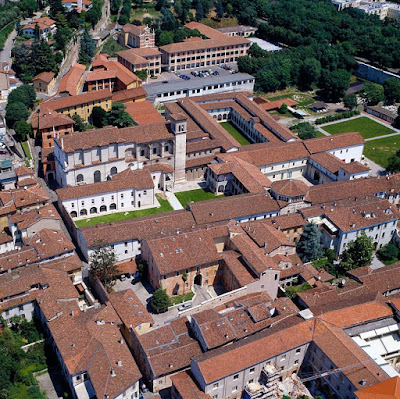Postcard 28 is on its way
to Brescia, Italy. We hope Monica & Giuseppe like it!
 |
| Brescia. Idueroccoli.com |
WHERE IS BRESCIA?
 |
| Location of Italy. Wikipedia |
 |
| Location of Brescia in Italy. Wikipedia |
Brescia is a city and comune in the region of Lombardy
in northern Italy. It is situated at the foot of the Alps, a few
kilometres from the lakes Garda and Iseo. With a population of 196,120, it is
the second largest city in the region and the fourth of northwest Italy. The
urban area of Brescia extends beyond the administrative city limits and has a
population of 672,822. The city is the administrative capital of the Province
of Brescia, one of the largest in Italy, with over 1,200,000 inhabitants.
 |
| Lake Garda. Iitaly.org |
BRESCIA IS FAMOUS FOR
...being the original production area
of the Franciacorta wine.
 |
| Franciacorta vino. Brescia Tourism |
...the prestigious Mille Miglia car
race, which starts and ends in this city.
 |
| Mille Miglia.com |
...being the homeland of Italian
caviar.
 |
| Acetaia Reale caviar. Melbury and Appleton.com |
PLACES TO VISIT
Brescia Castle
The ancient part of Brescia, Roman Brixia so-called
since the first century BC because of the rocky, hilly ground on which it is
built , is bounded to the north-east by Cidneo Hill (245m). Brich was the
Celtic word meaning rocky summit, high places. And the hill with its wonderful
view over the whole city, has represented the most important element in the
town's history from the time of the
first settlements in the Bronze age up until the eve of the XX century.
 |
| Brescia Castle. Turismobrescia.it |
Santa Giulia City Museum
The convent of San Salvatore, later named after Santa Giulia (915) was
founded at the wish of King Desiderius and his wife Ansa in 753 AD, and built
on a particularly rich archeological site ( the remains of Roman domus have
been found under the basilica of San Salvatore and in the kitchen garden of
Santa Giulia.
 |
| Convent of San Salvatore, Turismobrescia.it |
Piazza della Loggia
 |
| Piazza della Loggia. Turismobrescia.it |
It is the most beautiful square in Brescia and was
inaugurated in 1433. It is dominated by the magnificent Renaissance Palace of
the Loggia, nowadays the town hall. Its building began in 1492. The upper part
was finished circa 1570 to the design of Jacopo Sansovino and Andrea Palladio.
The splendid decorative sculpture that adorns the palace is in classical style.
On the south side, the
15th and 16th century façades of the Monti di Pietà are worthy of note as tombstones and other
pieces of Roman stonework have been set into their walls.
The Palace of the Loggia
 |
| Palace of the Loggia. Turismobrescia.it |
The present loggia was
built to replace the previous one built between 1434 and 1436. The first stone
was laid in 1492 with a solemn ceremony and the building work continued until
about 1570, under the supervision of numerous architects: Tommaso Formentone,
then Gasparo da Coirano, Andrea Palladio, Jacopo Sansovino, Galeazzo Alessi,
Giovanni Rusconi and Ludovico Beretta.
The Queriniana Library and the
Bishop's Palace
 |
| Queriniana Library. Turismobrescia.it |
The Queriniana library was founded
in 1747 and opened to the public by Cardinal Angelo Maria Querini, formerly
librarian at the Vatican library, well known for his bibliophily.
He had the monumental palace designed and built by the
architect Marchetti and donated his remarkable private bibliographic
collections, legating a considerable sum to enable the library to expand in the
future.
The Old Cathedral
 |
| The Old Cathedral. Turismibrescia.it |
It was built at the end of the XI century on the ruins
of the winter basilica of Santa Maria Maggiore. The central block is formed of
two cylindrical parts of stone, one on top of the other; the circular
ambulatory still has the original doorways, which are lower than the present
street level, and has large arched windows, while the upper tambour has smaller
windows and is relieved above by pilaster strips and small arches in brick, on
which the roof rests.
LIFESTYLE
Known as a city for culture lovers for the quality of
its architecture, museums and exhibitions, it’s a perfect town for strolling.
Small, with much of the historic centre pedestrianized, it is full of ancient
buildings, attractive shops and piazzas. Unlike many other cities, the modern
business development has been kept out of the city’s heart, giving the historic
centre great visual appeal.
 |
| Promotional poster Brescia Tourism.it |
Brescia has some very good options for dining out. The
best thing to try in the city would be local food; Brescian food is known to be
quite hearty and heavy on butter and beef. Some good local dishes to try are
Casoncelli, tortellini with beef, polenta taragna, spiedo etc. Another thing to
try here are pizzas, there are plenty of pizzerias here in Brescia that have
some great varieties of pizzas. Also, there are plenty of cafes and Osterias
here that sell some great local cuisine. There are quite a lot of local dishes
like polenta which are only available here during winters.
 |
| Casonelli. Brescia |
To discover more about Brescia watch the video below:
Sources:
Italy is a marvellous country!
ReplyDelete